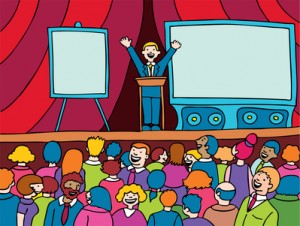Mere words are cheap and plenty enough, but ideas that rouse and set multitudes thinking come as gold from the mines ~ A. Owen
Have you listened to a speech or presentation that left you not knowing what was said and why you attended the event in the first place? I have.
Have you made a speech or presentation that left your audience asking themselves why they bothered to turn up? I have.
In todays fast changing world, one of the demands of your audience as you speak and make presentations is that you give them something to remember and something to make their lives better. Speaking is a means of communicating a message. Messages that are remembered always have something that resonates with the listener and something that brings a challenge to change.
Even when your speech is to inform or to entertain, it will make a difference to your audience if your message carries with it the seed of life change. How do you do this?
7 Tools For Making Impact In Your Speech And Presentations
- Have A Clear Objective That Is Tailored To Your Audiences Need.
What identified need does your audience have that your presentation is set out to meet or provide a solution for? You can gauge this by simply identifying who will be in your audience, what are some of the challenges they have and what would you want them to do differently after your presentation.
- Connect With Your Audience
You can increase you connection with your audience by arriving early. This allows you time to get acquainted with your audience.
Connection is increased when you are talk personally to people. By using the words “you” and “your” in your speech, you can speak directly to one person with several others listening in. This makes your presentation personal and I the listener will give you my attention because I want to hear what you have to say to me.
- Have a Clear Structure.
To make it easy for your listeners, you will need to ensure that your speech has a clear and easily identifiable structure. This will usually be made up of an opening, a body and a closing.
You opening is there to turn audience attention away from many other things that can possibly occupy their mind in that moment and to listen to you the speaker. It should also make the audience feel at ease in your presence.
The body of your speech will contain all the points you have to make laid out in a clear and logical manner. This will make it easier for listeners to follow and understand.
Your closing should contain a recap of your main points and clear next step. If you have presented a challenge for change, you want people to take action immediately and start implementing your solution.
- Have Just Enough Content.
Many attempts to communicate are nullified by saying too much ~ Robert Greenleaf
In my opinion, it is always better to leave your audience yearning to know more than to give them so much that they get confused about what you want them to learn or do. You cannot say it all in one presentation. Based on the time allocated, decide on what is important and stay focused on it.
There is an old speakers saying that When you squeeze your information in, you squeeze your audience out”.
- Make You Points Stick
Each point you make will have a chance of being remembered if you
- Base it round a story, acronym or an activity
- Include questions and statements that cause your audience to reflect on your point and think about how it can be applied to their lives.
- Include a method or solution for applying your point
- Show the benefits to be derived from making the changes you are proposing
- Effectively use transitions.
An effective transition from one point or section to another will include a summary of the point or section and a preview of what you are about to say. This helps the listener to recollect what you have just said and create an interest in what you are about to say. It also helps the listener to know when you have finished with one point and you are about to start another.
- Make Your Closing Memorable.
In any speech or presentation, the last thing you say is alway the first thing your listeners remember. So be intentional about your closing. Leave your audience on a high note and never close with a question and answer session.
In your closing, recall all your main points, include a clear call to action or next step and leave your audience feeling good.
They may forget what you said, but they will never forget how you made them feel ~ Carl W. Buechner
Why not add your own tools for speaking with impact by leaving a comment.


